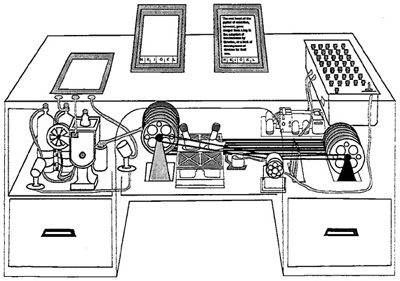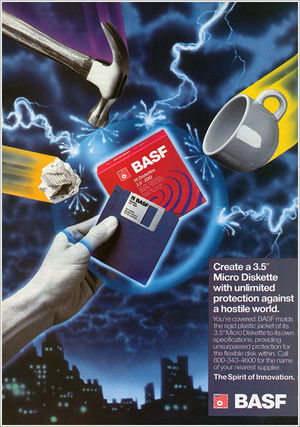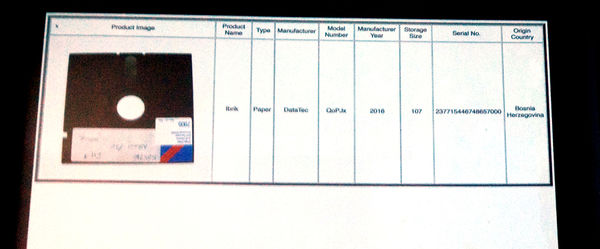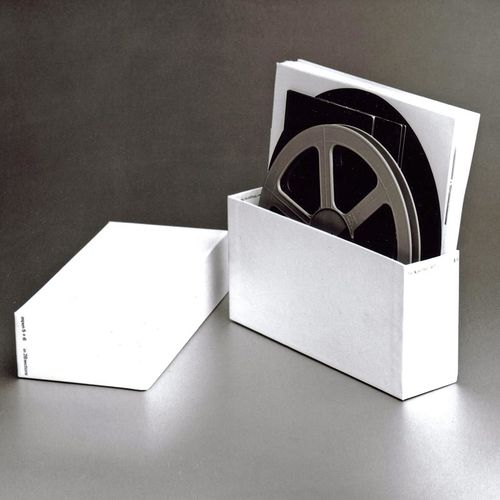User:ThomasW/First Proposal Outline v3: Difference between revisions
No edit summary |
|||
| (3 intermediate revisions by one other user not shown) | |||
| Line 1: | Line 1: | ||
https://media.giphy.com/media/jvu00LhbjzAJi/giphy.gif | https://media.giphy.com/media/jvu00LhbjzAJi/giphy.gif | ||
[[steve's mashup]] | |||
'''//////// WARNING DYSLEXIA AHEAD \\\\\\\\\//////// WARNING DYSLEXIA AHEAD \\\\\\\\\''' | '''//////// WARNING DYSLEXIA AHEAD \\\\\\\\\//////// WARNING DYSLEXIA AHEAD \\\\\\\\\''' | ||
| Line 54: | Line 56: | ||
'''“The design artefact you leave behind will be your ultimate legacy" (Beirut ,2006, p6) | '''“The design artefact you leave behind will be your ultimate legacy" (Beirut ,2006, p6) | ||
My work will explore people relationship to storage mediums with the main focus on digital information storage. The project will exist in the form of collection of printed and non printed works. | My work will explore people relationship to storage mediums with the main focus on digital information storage. The project will exist in the form of collection of printed and non printed works. | ||
One of the main works “My Hard-Drive Died Along With My Hearth” is a book that contains all of the tweets from my twitters collection of tweets about peoples hard-drive dyeing. All of the printed material will be printed | One of the main works “My Hard-Drive Died Along With My Hearth” is a book that contains all of the tweets from my twitters collection of tweets about peoples hard-drive dyeing. All of the printed material will be printed and collected as one single or multiple books. Other parts will/can be video work, sound work. I also see that the thesis and “My Hard-Drive Died Along With My Hearth” will be combined into one publication with some supporting material. | ||
The reason to have a lot of different material, is that by having a collection of work, you put in the hand of the that got the collection to decide to how to store it, If they want to store it together or spilt it up is up to them. Books with books, posters with posters.. | The reason to have a lot of different material, is that by having a collection of work, you put in the hand of the that got the collection to decide to how to store it, If they want to store it together or spilt it up is up to them. Books with books, posters with posters.. | ||
The thesis will also be in collection, but also will exist in an online distributed form on different web-servers and refaces as active hyperlink, idea will exposes it the future of “link-root” where links will die because of the ephemerality of the structure of the web. | The thesis will also be in collection, but also will exist in an online distributed form on different web-servers and refaces as active hyperlink, idea will exposes it the future of “link-root” where links will die because of the ephemerality of the structure of the web. | ||
| Line 77: | Line 79: | ||
*Abreu, Amelia (2015) The Collection and the Cloud, The New Winquiry [Online] Available: http://thenewinquiry.com/essays/the-collection-and-the-cloud/ .(Accessed:10.10.2015) | *Abreu, Amelia (2015) The Collection and the Cloud, The New Winquiry [Online] Available: http://thenewinquiry.com/essays/the-collection-and-the-cloud/ .(Accessed:10.10.2015) | ||
* [ | |||
* [https://pzwiki.wdka.nl/mediadesign/User:ThomasW/Notes Full reading & research list] | |||
Latest revision as of 13:55, 17 February 2016

//////// WARNING DYSLEXIA AHEAD \\\\\\\\\//////// WARNING DYSLEXIA AHEAD \\\\\\\\\
As Frank Zappa said "Without deviation from the norm, progress is not possible." so here is a project proposal WAY PAST DEADLINE.
"Constant on the edge of oblivion 26.11.15 "
For my graduation project at Piet Zwart Institute, I want to question the Utopic view that any given new electronic storage medium is the final solution to our storage needs, by the fact that nothing stays permanent, and has never been. Since the beginning of history there have always been great promises for the future of information storage. I want to explore this question by making a book that is a collection of work on the topic of memory loss in the digital age. The book will exist in the form of a box in the size of an archive box. In the box there will be different works like books, posters and other media that address the topic. On the books will be “My Hard-Drive Died Along with my Heart” that contains 750 tweets from twitter that all talks about peoples loss after their hard-drives dies. The other is the project “Top 404”, a project exploring websites in printed from where I compare the old and newer versions of them in current form. “We have the capacity to store everything for possible recall, but these same extended memory technologies are capable of generating oblivion in other ways—not least of which is through the technology.” (Gabrys, 2007, p120-123 )“
Introduction
Today we are often promised instant relocation and storage for free. How does this effect our connection to what we make? And how does this supposedly “easy life” change what we make and think about how we store it? My interest in the topic of finding and spreading information and knowledge started early by visiting the school library at the age of nine for technology and history books. Later in life I made a computer game magazine when I was 13 years old. I had folders of images, texts and project files from the project, but even being incredibly careful where I saved them, moving them around from computers to floppy disks to other computers, it all got lost somewhere.
Now its not just computer games, but history itself that is in danger: we put information onto platforms that claim they will archive for ever, “they tell its safe and saved, you don’t need to think about it” but history tells us that platforms and formats never stays forever. From papyrus or the next “cloud” services, they all will disappear. “Your data maybe safe for tomorrow, but what about a 50 or 100 years from now? And is it really that important? “Digital is the paradigm for content and quantity of information; analogue is the paradigm for usability and interfacing.” (Ludovico,2013,p151) Printed books can last hundreds of years if they are not exposed to fire, water, war and the stupidity of man, but a digital text can disappear and be left unaccessible in the future on the reasons like, unsupported file formats, dead storage formats, defunct “cloud” services or End User Licenses Agreements that deny you to the right to save or delete your own information. Online platform or “the cloud” are now often put forward as a final solution for your storage problems, but not even they can guaranty that they still be in business in one months time or what about 100 years from now? By looking back at history, no formats have truthfully been everlasting without a constant supervision and copying of its content over to new formats. By being more aware how things work and being the one that decides whats stays and what gets deleted you can control what what to keep or what to deleted. “paper was introduced during the ninth or tenth centuries, and the first paper found there is of the oriental type (called bombykinon or bambakeron). The fact that is was cheap than and other material gradually gave it ascendancy, but its rapid deterioration was a matter of great concern to the monks” (Fernando, 2008, p95)
Relation to previous practice
'“It must be understood that as long as art stand aside from the problems of life it will only interest a very few people.” (Munari,1966, p25) During my Bachelor. I made a project called “The Library of Babel” based on the short story by the same name by the Argentinian author Jorge Luis Borges. This project was made on the topic of “bit-rot” in text documents. This project got me really interesting in the long term storage of information and how we as society deal with it. A thread that goes through my previous projects are always these topics that I find interesting, but never get the attention I think they deservers.
 “The Library of Babel”
“The Library of Babel”
In my previous term at Piet Zwart I made the project “Imagery Storage Formats”, this project explored. With my random generating encyclopaedia of imagery storage formats I wanted to make fun of the computer industry and putting a question out to people, If the new formats are so good and as stable as they say they are, can you really believe them? Since the invention of electronic storage devices, there have been a lot of promises of the durability of the medium from their inventors. The computer industry have spent 50 years of over-promising and under-delivery. If the computer industry can make loft claims, why can I not make up my own collection of storage formats? With my random generating encyclopaedia of imagery storage formats. I wanted to make fun of the computer industry and put a question out to people; Are the new formats really so good that you can believe that you data is safe?
Relation to a larger context
'“In 1961, the British science fiction author Arthur C. Clarke suggested that “any sufficiently advanced technology is indistinguishable from magic.” (Feigelfeld, 2015, Online)“
 Vannevar Bush’s Memex machine.
Vannevar Bush’s Memex machine.
Technology is becoming more and more distant from the peoples understanding of it. The first to start using a technology know more about how it works than those who become acquainted later. Most computer and computer storage technology’s are mysterious. Its hidden away in black boxes, warning labels and security screws and hyper-bull marketing words. The technology industry has always been “fetishising the notion of optimization” From paper medium to the cloud, people have always been looking for quick solutions for their problems, storing their memory is one of them.
Rather than getting caught up in speed, then, we must analyse, as we try to grasp a present that is always degenerating, the ways in which ephemerality is made to endure. What is surprising is not that digital media fades but rather that it stays at all and that we stay transfixed by our screens as its ephemerality endures. (Hui Kyong Chun, 2008, p171 )
Since Xerox proclaimed in “The Office of the Future” in Business Week in June 1975 that we will soon be in a time of the “paperless office” and paper where going to be a thing of the past. But things change over time and a lot of big commercial newspapers and magazines have moved online creating there own problems on how to archive their information. Paper is still the most stable and archive media for long term storage of information, paper version exist, but digital magazines, websites and CD-ROM are long dead. Writer Rick Poyner said he regret of the loss of permanences that exist with paper compared to digital versions of his writings.
Thesis intention
The thesis will focus on the topic of society and how we deal with this increasing amount of information and how and why we are making that amount of information. “Can less mean more?” “I am afraid that future theorists and historians of computer media will be left with not much more than the equivalents of the newspaper reports and film programs from cinema first decade. They will find that analytical texts from our area recognize the significance of computers take over of culture, yet, by and large, contains speculations about the future rather then a record and theory of the present. (Manovich,2001, p6-7)“
Practical steps
“The design artefact you leave behind will be your ultimate legacy" (Beirut ,2006, p6) My work will explore people relationship to storage mediums with the main focus on digital information storage. The project will exist in the form of collection of printed and non printed works. One of the main works “My Hard-Drive Died Along With My Hearth” is a book that contains all of the tweets from my twitters collection of tweets about peoples hard-drive dyeing. All of the printed material will be printed and collected as one single or multiple books. Other parts will/can be video work, sound work. I also see that the thesis and “My Hard-Drive Died Along With My Hearth” will be combined into one publication with some supporting material. The reason to have a lot of different material, is that by having a collection of work, you put in the hand of the that got the collection to decide to how to store it, If they want to store it together or spilt it up is up to them. Books with books, posters with posters.. The thesis will also be in collection, but also will exist in an online distributed form on different web-servers and refaces as active hyperlink, idea will exposes it the future of “link-root” where links will die because of the ephemerality of the structure of the web. A supporting element is a poster with all of the tweets, this can be put on a wall as a reminder to keep you data safe. Loss of control of the personal archive means a loss of societal control of the cultural record. (Abreu, 2008, Online)
For inspiration one can look at Aspen 5+6 on how maybe the final result maybe will look like
Bibliography
- Gabrys, Jennifer (2007) DIGITAL RUBBISH a natural history of electronics, Paperback , United States of America ,The University of Michigan Press
- Ludovico, Alessandro (2013) Post Digital Print, Onomatopee
- Munari, Bruno, Design as Art (1966) England, Penguin
- Feigelfeld, Paul (2015) Media Archaeology Out of Nature: An Interview with Jussi Parikka, e-flux.com [Online] Available: http://www.e-flux.com/journal/media-archaeology-out-of-nature-an-interview-with-jussi-parikka/ (Accessed:28.05.2015)
- Beirut, Michael, Drenttel, William, William, Steven (2006) Look Closer Five, Critical Writings on Graphic Design, New York, Allworth Press
- Manovich, Lev, (2001) The Language of New Media, United States of America, The MIT Press
- Baez, Fernando (2008) A Universal History of the Destruction of Books: From Ancient Sumer to Modern-day Iraq, Atlas & Co.
- The Enduring Ephemeral, or the Future Is a Memory Author(s): By Wendy Hui Kyong Chun Source: Critical Inquiry, Vol. 35, No. 1 (Autumn 2008), pp. 148-171 Published by: The University of Chicago Press Stable URL: http://www.jstor.org/stable/10.1086/595632 . Accessed: 22/09/2015 09:06
- Abreu, Amelia (2015) The Collection and the Cloud, The New Winquiry [Online] Available: http://thenewinquiry.com/essays/the-collection-and-the-cloud/ .(Accessed:10.10.2015)




